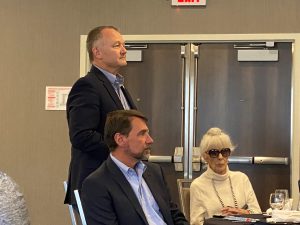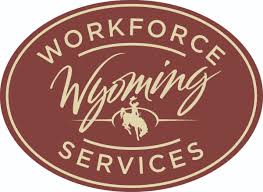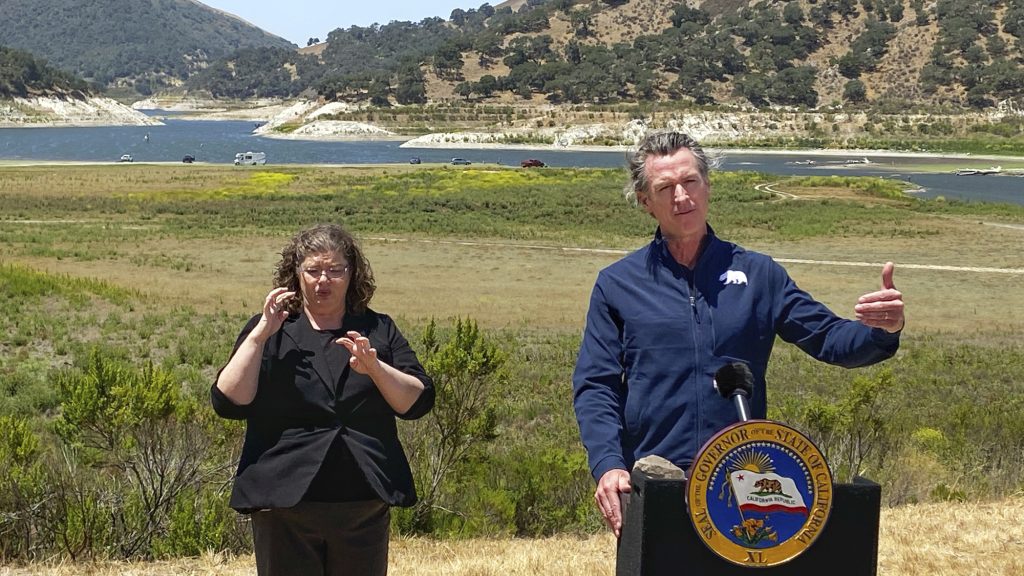Yellowstone & Grand Teton Superintendents Praise Partnerships in Cody
Written by Andrew-Rossi on May 23, 2022
With Yellowstone National Park amid its 150th anniversary, the superintendents of Yellowstone and Grand Teton celebrate “fantastic” partners in Cody and the other gateways in Wyoming and Montana.
Monday, May 23, was the 70th National Parks Day in Cody. As in years past, chamber members of the Cody Club gathered to hear the superintendents of Yellowstone and Grand Teton National Parks – Cam Sholly and Chip Jenkins – discuss their parks and the importance of gateway communities like Cody.
“Cody’s where it’s at,” Sholly said as he began talking to the assembled crowd at Cody’s Holiday Inn. Sholly went on to call Cody and Park County “tremendous partners” in Yellowstone’s efforts.
Both superintendents are still relatively new to the job – Sholly’s in his third year leading Yellowstone, while Jenkins has served 17 months in Grand Teton. Nevertheless, they’ve both led their parks during the “interesting lead-in” to the 150th anniversary of Yellowstone’s establishment.

Yellowstone Superintendent Cam Sholly stands to answer a question while Grand Teton superintendent Chip Jenkins sits after his remarks to the Cody Club.
Sholly says there is no shortage of challenges and opinions, and often the few voices on the fringes of either side of an issue are the loudest. But, he says, most of us are in-between – and that’s where to find the best solutions.
Governor Mark Gordon also received a shout-out from Sholly, who called the governor a “true partner.”
“Your governor is doing an outstanding job for you,” Sholly said of the governor, who is currently seeking a second term.
The primary goal of the 150th anniversary is strengthening the park’s tribal relations as part of the National Park Service’s mission to tell American stories.
“We are upping our game with the tribes,” Sholly explained, “There’s a bigger emphasis on our tribal relations. (The N.P.S.) tells the stories of America – good and bad. And nobody can tell tribal stories better than the tribes themselves.
Sholly said another tipi village is being set up at the Roosevelt Arch in Gardiner. Fourteen tribes are already participating this year.
One of the best accomplishments of the last century and a half is, in Sholly’s view, the successful rehabilitation of Yellowstone’s natural landscape.
“After 150 years, we can say the park is in better condition than it was in 1872,” Sholly says. Much of that improvement has been during the last four to five decades; as Sholly says, the first hundred years “didn’t do the best job” of preserving the park for future generations.
But since then, the park has been “putting the pieces of the ecosystem back together.” Sholly cited several success stories: the 6,000 bison in the park (much more than in 1872,) the return of grizzlies, wolves, and cougars, & the stabilization of Yellowstone cutthroat trout after years of intense effort.
Chip Jenkins, Superintendent of Grand Teton National Park, also spoke about the importance of gateway communities and the great partnerships between the parks and Wyoming.
Jenkins focused on how communities are learning to share their space with wildlife. This issue is significant due to the international sensation of Grizzly 399 and her cubs (what Jenkins called a “12,000-pound basketball team of bears.”)
Being bear-aware is especially important now that her four cubs are independent and trying to survive in the park. Jenkins sees communities coming together to protect people and animals, which he categorizes as part of Wyomingites’ deep appreciation for wildlife.
Sholly and Jenkins share a close personal and professional bond, especially since both parks share visitation and face similar challenges. Both superintendents said the focus of the future is infrastructure, primarily housing for the ever-growing number of N.P.S. employees.
Housing, Sholly says, is an issue many don’t consider or underestimate. But as rent and property prices rise in gateway communities, both Sholly and Jenkins must ask, “where is a wildlife biologist going to live?
Both superintendents ended their Cody Club addresses with the same message – we’re strongest together, and the parks thrive because of the eager cooperation of the states and gateway communities of Yellowstone and Grand Teton.
“That’s why we’re here for you,” Sholly said.



